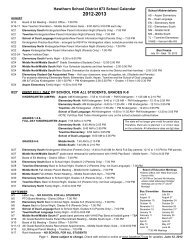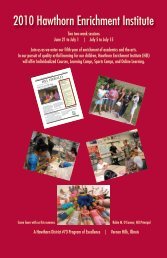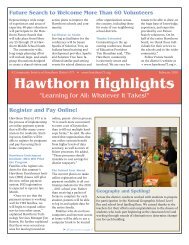2013-14 budget - Hawthorn School District 73
2013-14 budget - Hawthorn School District 73
2013-14 budget - Hawthorn School District 73
Create successful ePaper yourself
Turn your PDF publications into a flip-book with our unique Google optimized e-Paper software.
Since the 1980’s, the State Board of<br />
Education has been monitoring the<br />
financial conditions of school districts.<br />
This annual cycle has evolved from<br />
publishing a Financial Watch List, to the<br />
assessment of all school districts’ fiscal<br />
health in the Financial Assurance and<br />
Accountability System (FAAS) to the<br />
new and more comprehensive <strong>School</strong><br />
<strong>District</strong> Financial Profile System.<br />
The overarching goal of the financial<br />
profile is to objectively assess the<br />
financial health of all school districts in<br />
order for the public to gain a better<br />
understanding of where their schools<br />
rank in comparison to others. This will<br />
be done through a process of<br />
benchmarking 5 indicators for school<br />
districts:<br />
Historically, we present the Total Profile<br />
Scores at our March Board Meeting.<br />
Your Profile and comments that the<br />
district has submitted, will then be listed<br />
on our website,<br />
www.isbe.net/sfms/p/profile.htm.<br />
The Five Indicators<br />
1. Fund Balance to Revenue Ratio:<br />
indicates the overall financial strength<br />
of the district for the prior year. It is<br />
the result of dividing the ending fund<br />
balances by the revenues for the four<br />
operating funds (Educational,<br />
Operations & Maintenance,<br />
Transportation, and Working Cash<br />
Fund) and, if applicable, a negative<br />
IMRF/FICA fund balance.<br />
2. Expenditure to Revenue Ratio:<br />
identifies how much a district spent<br />
for each dollar it received. It is<br />
calculated by dividing total<br />
expenditures by the revenues for the<br />
operating funds. Also considered in<br />
this calculation is the remaining fund<br />
balances, so if a district is deficit<br />
spending in a particular year, but has<br />
sufficient fund balances to cover the<br />
expenditures, the district will not be<br />
penalized.<br />
3. Days Cash on Hand: provides a<br />
projected estimate of the number of<br />
days a district could meet operating<br />
expenses if no additional revenues<br />
were received. It is calculated by<br />
dividing the expenditures of the four<br />
operating funds by 360 (days) to<br />
obtain an average expenditure per<br />
day. Then the total cash on hand<br />
and investments (end of fiscal year)<br />
for the same funds are divided by the<br />
average expenditures per day.<br />
4. Percent of Short-Term Borrowing<br />
Maximum Remaining: reflects the<br />
remaining short-term debt extension<br />
available to the district. The<br />
calculated percentage is 100% less<br />
the percentage of Tax Anticipation<br />
Warrants that remain outstanding.<br />
5. Percent of Long-Term Debt Margin<br />
Remaining: is a summary of<br />
numerous items relating to long-term<br />
debt distinguished from debt secured<br />
by short-term instruments.<br />
What the composite score indicates<br />
Scoring is predicated upon a three-step<br />
process:<br />
♦ RANGE – is dependent upon cut<br />
scores; each indicator is calculated<br />
and the results are slotted into a<br />
category of a four, three, two, or one<br />
with four being the highest and best<br />
category possible<br />
♦ WEIGHTING – once the range of the<br />
indicator is set, the respective score<br />
is weighted<br />
♦ TOTAL – the sum of weighted<br />
indicators determines the financial<br />
strength and designation of each<br />
school district













